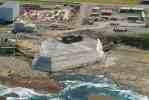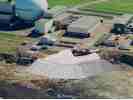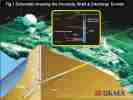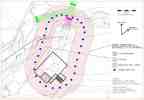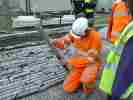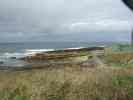|
26 January 07 21 March 2006 This major step in the project will allow the contents of the shaft to be isolated from the surrounding environment by physically restricting water movement to and from the shaft. Once complete, the grout curtain will provide reassurance against leakage, eliminate any lingering doubts about the shaft being a source of particles in the marine environment, and create a stable environment for waste retrieval in the future. Following a period of public consultation in 2004, UKAEA Dounreay selected grouting as its preferred method of isolating the 65-metre deep facility from the surrounding groundwater. To allow the boreholes to be drilled requires the use of a raised working platform, constructed by placing layers of rolled compacted concrete built up from the height of the existing Dounreay foreshore to the height of the existing shaft building. The boreholes will be drilled to a depth of up to 80 metres in a ring around the shaft. Ultra fine grout will then be injected into the boreholes under pressure in order to penetrate any existing rock fractures. Once solidified the grout will form a barrier reducing the volume of groundwater currently flowing into the shaft which will result in less groundwater having to be dealt with as contaminated waste. In addition, the proposed development involves the reinforcement of the existing shaft plug and infilling of a section of the adjacent liquid effluent discharge tunnel. Trials have successfully been carried out at Dounreay to provide detailed data on the number of boreholes required and spacing, selection of grouts that will be used, grouting pressures and volumes for the grouting process to ensure optimum filling of fractures in the rock. Trials have recently been completed on the drilling and grouting of the shaft simulation grout wall which has provided further confidence in the grouting process. Simon Middlemas, Dounreay Deputy Director, said: “Being granted planning permission to isolate the shaft is a major step forward for the decommissioning of the Dounreay site. The shaft is one of the major nuclear decommissioning challenges in the world. The decision by Highland Council to grant planning permission allows us to move forward with our programme to decommission the site as planned.” The £16 million contract to isolate the shaft was awarded in October 2004 to Ritchies, the specialist geotechnical division of Edmund Nuttall Ltd. It is expected to take between two to four years to complete. For more information
about the shaft see: 13 October 05 The application to the Highland Council seeks consent to isolate the contents of the shaft from the surrounding environment by physically restricting water movement to and from the shaft by means of a grout curtain. This will require building a raised working platform, drilling boreholes and injecting grout into the boreholes. Once complete, the grout curtain will provide reassurance against leakage, eliminate any lingering doubts about the shaft being a source of particles in the marine environment, and create a stable environment for waste retrieval in the future. (Note - The grout referred to in this situation is some of the most advanced finely ground cements available and is at the cutting edge of the technology and not to be confused with grout used in tiling). Following a period of public consultation in 2004, UKAEA Dounreay selected grouting as its preferred method of isolating the 65-metre deep facility from the surrounding groundwater. This will involve drilling approximately 350 to 400 boreholes to a depth of 80 metres in an oval ring around the shaft. Grout will then be injected into the boreholes under pressure in order to penetrate any existing rock fractures. Once solidified the grout will form a barrier reducing the volume of groundwater currently flowing into the shaft which will result in less groundwater having to be dealt with as contaminated waste. To allow the boreholes to be drilled requires the use of a raised working platform, constructed by placing layers of rolled compacted concrete built up from the height of the existing Dounreay foreshore to the height of the existing shaft building. In addition, the proposed development involves the reinforcement of the existing shaft plug and infilling of a section of the adjacent liquid effluent discharge tunnel. Successful field trials at Dounreay have provided detailed data on the number of boreholes required and spacing, the selection of grouts that will be used, grouting pressures and volumes for the grouting process and ensure optimum filling of fractures in the rock. Trials are continuing at Dounreay over the next few months on the drilling and grouting of the shaft simulation grout wall, to provide further confidence in the grouting process. Simon Middlemas, Dounreay Deputy Director, said: “Hydraulic isolation of the shaft is the first phase of one of the major nuclear decommissioning challenges in the world. The field trials have been completed successfully through excellent team work between UKAEA and Ritchies, allowing us now to submit the planning application. We will continue to work closely with Ritchies to ensure high standards of safety and environmental protection are maintained.” UKAEA have been advised that a formal Environmental Impact Assessment for this proposal was not required. However while a formal environmental statement under the EIA Regulations has not been submitted with the planning application, it is accompanied by a supporting statement which considers the likely environmental effects of this work and which sets out mitigation measures proposed to avoid or minimise any impacts. UKAEA announced in October 2004 the award of a contract to Ritchies, the specialist geotechnical division of Edmund Nuttall Ltd to isolate the shaft at a cost in the region of £16 million. Subject to consents, building the raised working platform is expected to commence in April 2006 with work on the existing shaft plug and liquid effluent discharge tunnel following. Borehole drilling and grouting is expected to commence in summer 2006 and will take between two to four years to complete. During construction of the subsea effluent tunnel at Dounreay in the 1950s, a 65-metre vertical shaft was excavated to remove the spoil. Following completion of the tunnel, the shaft was plugged at the base and authorised by the Scottish Office for the disposal of solid intermediate-level waste. The last disposal took place in 1977 prior to an explosion. The item that caused the explosion in 1977 was basically sodium which mixed with water and it is thought a spark from a fan may have ignited the mixture. In 1998, the Government announced that it had accepted a recommendation by UKAEA that the best practicable environmental option to decommission the shaft would be to retrieve the waste. The possibility of another explosion is thought to be very unlikely as the original one was caused by a specific chemical reaction at the time. This is not likely to happen now. Never theless all the retrieval of the material in the shaft will be by remotely controlled robots. Concept designs have been developed for waste retrieval, treatment and storage facilities to enable the emptying of the shaft to take place. A number of local people are already employed on the grouting rigs and it is expected that up to 20 people will be employed on the site. The job may take up to three years to complete. Retrieval of the items in the shaft will take several years and dealing with them and employ several hundred people in different aspects of the work. The construction of the jacket and the use of the grouting material is at the cutting edge what can achieved in the mining and other industries and the work takes it to a new level. The expertise being gained in this operation is expected to be useful in other places in the world. For more information about the shaft, see http://www.ukaea.org.uk/dounreay/waste.htm For more information about Ritchies, see http://www.edmund-nuttall.co.uk/ritchies.html |
